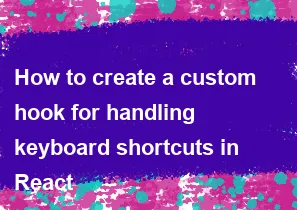How to create a custom hook for handling keyboard shortcuts in React

Creating a custom hook for handling keyboard shortcuts in React involves using the useEffect hook to attach event listeners for key presses and cleaning up those listeners when the component unmounts. Here's a simple example of a custom hook for handling keyboard shortcuts:
jsximport { useEffect, useRef } from 'react';
const useKeyboardShortcut = (targetKey, callback) => {
const callbackRef = useRef(callback);
useEffect(() => {
callbackRef.current = callback;
}, [callback]);
useEffect(() => {
const handleKeyPress = (event) => {
if (event.key === targetKey) {
callbackRef.current();
}
};
window.addEventListener('keydown', handleKeyPress);
return () => {
window.removeEventListener('keydown', handleKeyPress);
};
}, [targetKey]);
};
export default useKeyboardShortcut;
Here's how you can use this custom hook in your component:
jsximport React from 'react';
import useKeyboardShortcut from './useKeyboardShortcut'; // adjust the path based on your project structure
const MyComponent = () => {
const handleShortcut = () => {
// Your logic for handling the shortcut goes here
console.log('Shortcut pressed!');
};
// Register 'A' as the target key for the shortcut
useKeyboardShortcut('A', handleShortcut);
return (
<div>
{/* Your component content */}
</div>
);
};
export default MyComponent;
In this example, the useKeyboardShortcut hook takes two parameters: targetKey and callback. It sets up a keydown event listener on the window object and checks if the pressed key matches the targetKey. If there's a match, it invokes the provided callback function.
Remember to clean up the event listener when the component unmounts to avoid memory leaks. The cleanup is done in the return statement of the useEffect hook.
You can customize this hook further based on your needs, such as supporting multiple keys, handling key combinations, or adding more sophisticated logic within the callback function.
-
Popular Post
- How to optimize for Google's About This Result feature for local businesses
- How to implement multi-language support in an Express.js application
- How to handle and optimize for changes in mobile search behavior
- How to handle CORS in a Node.js application
- How to use Vue.js with a UI framework (e.g., Vuetify, Element UI)
- How to configure Laravel Telescope for monitoring and profiling API requests
- How to create a command-line tool using the Commander.js library in Node.js
- How to implement code splitting in a React.js application
- How to use the AWS SDK for Node.js to interact with various AWS services
- How to use the Node.js Stream API for efficient data processing
- How to implement a cookie parser middleware in Node.js
- How to implement WebSockets for real-time communication in React
-
Latest Post
- How to implement a dynamic form with dynamic field styling based on user input in Next.js
- How to create a custom hook for handling user interactions with the browser's device motion in Next.js
- How to create a custom hook for handling user interactions with the browser's battery status in Next.js
- How to implement a dynamic form with dynamic field visibility based on user input in Next.js
- How to implement a dynamic form with real-time collaboration features in Next.js
- How to create a custom hook for handling user interactions with the browser's media devices in Next.js
- How to use the useSWRInfinite hook for paginating data with a custom loading indicator in Next.js
- How to create a custom hook for handling user interactions with the browser's network status in Next.js
- How to create a custom hook for handling user interactions with the browser's location in Next.js
- How to implement a dynamic form with multi-language support in Next.js
- How to create a custom hook for handling user interactions with the browser's ambient light sensor in Next.js
- How to use the useHover hook for creating interactive image zoom effects in Next.js